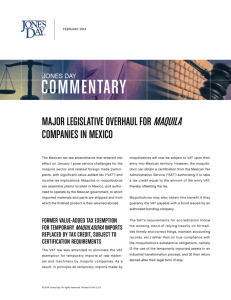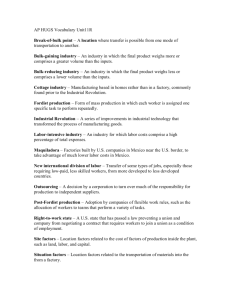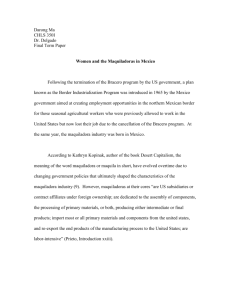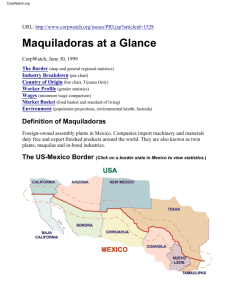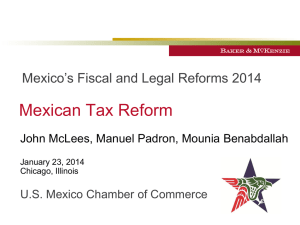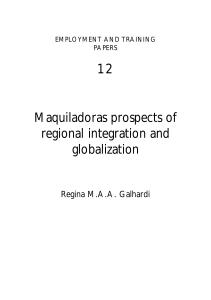Inside Mexico's Maquiladoras: Manufacturing Health Disparities
advertisement
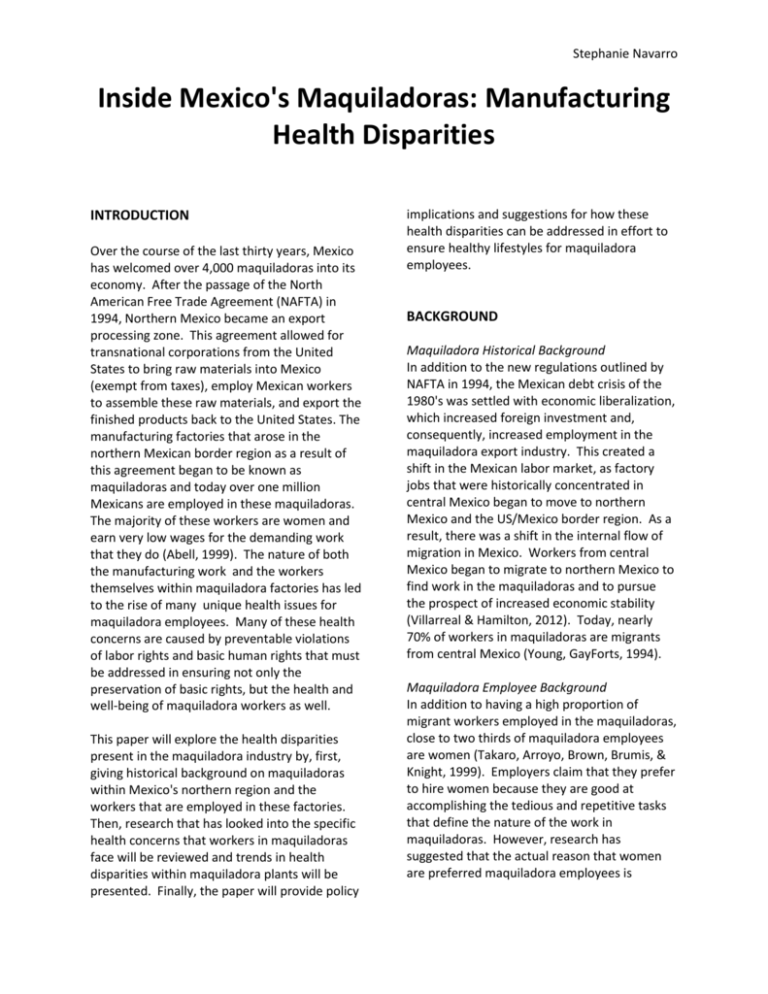
Stephanie Navarro Inside Mexico's Maquiladoras: Manufacturing Health Disparities INTRODUCTION Over the course of the last thirty years, Mexico has welcomed over 4,000 maquiladoras into its economy. After the passage of the North American Free Trade Agreement (NAFTA) in 1994, Northern Mexico became an export processing zone. This agreement allowed for transnational corporations from the United States to bring raw materials into Mexico (exempt from taxes), employ Mexican workers to assemble these raw materials, and export the finished products back to the United States. The manufacturing factories that arose in the northern Mexican border region as a result of this agreement began to be known as maquiladoras and today over one million Mexicans are employed in these maquiladoras. The majority of these workers are women and earn very low wages for the demanding work that they do (Abell, 1999). The nature of both the manufacturing work and the workers themselves within maquiladora factories has led to the rise of many unique health issues for maquiladora employees. Many of these health concerns are caused by preventable violations of labor rights and basic human rights that must be addressed in ensuring not only the preservation of basic rights, but the health and well-being of maquiladora workers as well. This paper will explore the health disparities present in the maquiladora industry by, first, giving historical background on maquiladoras within Mexico's northern region and the workers that are employed in these factories. Then, research that has looked into the specific health concerns that workers in maquiladoras face will be reviewed and trends in health disparities within maquiladora plants will be presented. Finally, the paper will provide policy implications and suggestions for how these health disparities can be addressed in effort to ensure healthy lifestyles for maquiladora employees. BACKGROUND Maquiladora Historical Background In addition to the new regulations outlined by NAFTA in 1994, the Mexican debt crisis of the 1980's was settled with economic liberalization, which increased foreign investment and, consequently, increased employment in the maquiladora export industry. This created a shift in the Mexican labor market, as factory jobs that were historically concentrated in central Mexico began to move to northern Mexico and the US/Mexico border region. As a result, there was a shift in the internal flow of migration in Mexico. Workers from central Mexico began to migrate to northern Mexico to find work in the maquiladoras and to pursue the prospect of increased economic stability (Villarreal & Hamilton, 2012). Today, nearly 70% of workers in maquiladoras are migrants from central Mexico (Young, GayForts, 1994). Maquiladora Employee Background In addition to having a high proportion of migrant workers employed in the maquiladoras, close to two thirds of maquiladora employees are women (Takaro, Arroyo, Brown, Brumis, & Knight, 1999). Employers claim that they prefer to hire women because they are good at accomplishing the tedious and repetitive tasks that define the nature of the work in maquiladoras. However, research has suggested that the actual reason that women are preferred maquiladora employees is because they are less likely to report workplace abuses and injustices (Abell, 1999). Findings on the basic demographics of average maquiladora workers report that maquiladora workers are less educated, less likely to own a car, and less likely to own a phone, as compared to the average Mexican worker. In addition, maquiladora workers work longer hours and receive lower wages than the national averages (Guendelman & Silberg, 1993). RESEARCH FINDINGS Numerous human rights violations and health risks have been found within the maquiladoras that line the US/Mexico border. Several noted human rights violations are tied to gender, socioeconomic status, and migrant status, among other things that impact many aspects of the worker’s lives. Women's Health As the majority of maquiladora workers are female, there are a host of gender specific issues that arise relating to work in the maquiladoras. The first issue involves pregnancy. Mexican labor law mandates that pregnant women receive paid maternity leave. However, research in maquiladoras has found a high rate of resignations among pregnant women, providing evidence for what many workers have reported as forced resignation due to pregnancy. Specifically, because employers do not want to pay for work that is not being done (i.e. paid maternity leave), managers force pregnant women to resign. In addition, many workers report abusive policies within the maquiladoras that make an attempt to ensure that workers do not become pregnant. These accounts range from reports that women are regularly punched in the stomach, such that they are unable to sustain pregnancies, to reports of managers monitoring menstrual cycles to ensure that workers are not pregnant (Abell, 1999). Research that has examined the reproductive health of female maquiladora workers has found that women working in maquiladoras experience high rates of menstrual irregularities, miscarriages, birth defects, premature birth, low birth weight, and infertility (Abell, 1999). Indeed, one study found that the incidence of babies being born at low birth weight to mothers who were employed in maquiladoras was 2.8 times higher than the average rate of low birth weight births (Villegas, Noriega, & Martínez, 1997). The second issue involves sexual harassment of the female workers by the managers of the maquiladoras. Examples of sexual harassment that researchers have found include managers offering workers a lighter workload in exchange for dates or sex with the female workers (Abell, 1999). As matriarchs of their families, many women who work in maquiladoras seldom reap the benefits of their work, as many of the resources that they earn go to supporting their families as opposed to themselves. These benefits include health care, which research has shown goes to support the health of men and children before benefiting women (Abell, 1999). Moreover, maquiladora workers live in poverty, meaning that families supported by maquiladora work often have limited health resources to begin with (Abell, 1999). These female workers thus have even less access to health care, as compared to other Mexican women. In addition, their impoverished status mandates that workers find housing in areas with high levels of environmental hazards. Specifically, many workers live in areas around the maquiladoras where housing is inexpensive, yet pollution is high due to emissions from the factories (Abell, 1999). Occupational Health There are also many strictly occupational hazards that effect workers at maquiladoras. The largest of these hazards involve the dangerous working environment in maquiladoras. Daily health threats that maquiladora workers face include handling toxic chemicals, using unsafe equipment and poorly designed workstations, working in extreme heat or cold and in conditions of poor ventilation and lighting, working in spaces with harmful noise levels, and performing work according to dangerously high production quotas (Abell, 1999). In terms of health outcomes, these hazards manifest themselves in high incidences of headaches, dizziness, nausea, anxiety, unusual fatigue, anemia, forgetfulness, stomach pain, nervous tension, vomiting, chest pressure, heart disease, circulatory problems, high blood pressure, respiratory problems, numbness and tingling in the extremities, back and shoulder pain, vision and hearing problems, allergies and skin problems, and physical injury (Abell, 1999). POLICY IMPLICATIONS In fact, one study found that maquiladora workers experienced upper back, neck and shoulder, and hand and wrist pain at incidence levels that were between forty and ninety percent above the average for general laborers (Harlow, Becerril, Scholten, Sánchez Monroy, & Sánchez, n.d.). Other research has shown that maquiladora workers utilize social health and welfare services at two to four times the rate of other workers, most likely due to this increase in occupational injuries (Villegas et al., 1997). High rates of workplace injury have been attributed to high levels of repetitive work, rapid assembly rate, strained postures, and excessive use of force (Meservy, Suruda, Bloswick, Lee, & Dumas, 1997). It is evident that policy is needed to address the largely present health concerns that accompany employment in maquiladoras. Widely present sexual harassment, occupational hazards, and health risks generated by poverty and migration status have all led to rampant health problems within maquiladoras. Policy must look to address these concerns individually and collectively, but must also be conscious of the unique barriers that exist in the maquiladora environment. In addition to the physical health effects of working in maquiladoras, many workers also report declines in mental health as well. Research has shown the workers have high stress levels due to the pressure to work quickly, infrequent break allowances, and job and wage insecurity (Abell, 1999). There have been some efforts to coordinate interventions that target the unique needs of workers in maquiladoras. One such intervention sought to raise awareness among workers about emergency contraception pills. Educational talks were given to workers, informational pamphlets were distributed, and kits with supplies and resources were given to the women working in maquiladoras. While it was found that the intervention did increase the knowledge and use of emergency contraceptive pills, it was also discovered that the factories are incredibly difficult settings to house intervention programs. Specifically, factory closures as well as management and staff opposition made reaching out to the maquiladora workers a very difficult task (García et al., 2008). The intervention to raise awareness about emergency contraceptive pills showed that interventions and policy measures do not have to be complicated, but that they do need to be strategic. It is not feasible to enact policies that plan interventions within the workplace, as there exist large power imbalances that make it difficult for interventions to be carried out fully. Instead, policy makers need to look outside the factories, to housing establishments where maquiladora workers live or to stores and other established places within communities where large numbers of maquiladora workers reside. In addition to ensuring that location of interventions is best suited to the specific needs of maquiladora workers, it is also important to remember that a high percentage of maquiladora workers are migrants, female, family matriarchs, and impoverished. All of these factors need to be considered in order to ensure that interventions are carried out in a culturally and structurally competent manner. However, outside of the realm of policy raising awareness about how workers can limit their exposure to harm in the workplace, is the great need for policy that protects the rights of these workers. In addition to violating many simple labor rights, work in maquiladoras also violates many major human rights as well. The government has a responsibility to protect these rights for all of its citizens. In this way, policy makers must revisit living and working conditions for maquiladora workers and develop policy that fights to protect their rights. In ensuring that these basic rights are protected, many improvements in individual health and well-being will follow. LINKS TO OTHER RESOURCES OF INTEREST o What is a maquiladora?: http://www.udel.edu/leipzig/texts2/vox128 .htm o Maquiladoras and the Border Economy: https://www.mtholyoke.edu/~shah20m/cla ssweb/index.html o Maquiladoras: the Twin Plant Assembly Program: http://www.pbs.org/kpbs/theborder/histor y/timeline/22.html o Maquiladora Solidarity Network: http://en.maquilasolidarity.org/ WORKS CITED Abell, H. (1999). Endangering women’s health for profit: health and safety in Mexico's maquiladoras. Development in Practice, 9(5), 595–600. doi:10.1080/09614529952729 García, S. G., Becker, D., de Castro, M. M., Paz, F., Olavarrieta, C. D., & Acevedo-García, D. (2008). Knowledge and opinions of emergency contraceptive pills among female factory workers in Tijuana, Mexico. Studies in Family Planning, 39(3), 199–210. Retrieved from http://www.ncbi.nlm.nih.gov/pubmed/18 853641 Guendelman, S., & Silberg, M. J. (1993). The health consequences of maquiladora work: women on the US-Mexican border. American Journal of Public Health, 83(1), 37–44. doi:10.2105/AJPH.83.1.37 Harlow, S. D., Becerril, L. A., Scholten, J. N., Sánchez Monroy, D., & Sánchez, R. A. (n.d.). The prevalence of musculoskeletal complaints among women in Tijuana, Mexico: sociodemographic and occupational risk factors. International Journal of Occupational and Environmental Health, 5(4), 267–75. Retrieved from http://www.ncbi.nlm.nih.gov/pubmed/10 633243 Meservy, D., Suruda, A. J., Bloswick, D., Lee, J., & Dumas, M. (1997). Ergonomic risk exposure and upper-extremity cumulative trauma disorders in a maquiladora medical devices manufacturing plant. Journal of Occupational and Environmental Medicine / American College of Occupational and Environmental Medicine, 39(8), 767–73. Retrieved from http://www.ncbi.nlm.nih.gov/pubmed/92 73881 Takaro, T. K., Arroyo, M. G., Brown, G. D., Brumis, S. G., & Knight, E. B. (1999). Community-based Survey of Maquiladora Workers in Tijuana and Tecate, Mexico. International Journal of Occupational and Environmental Health, 5(4), 313–315. doi:10.1179/oeh.1999.5.4.313 Villarreal, A., & Hamilton, E. R. (2012). Rush to the border? Market liberalization and urban- and rural-origin internal migration in Mexico. Social Science Research, 41(5), 1275–91. doi:10.1016/j.ssresearch.2012.02.007 Villegas, J., Noriega, M., & Martínez, S. (1997). [Work and health in the Mexican “maquiladora” industry: a dominant trend in dominated neoliberalism]. Cadernos de Saude Publica, 13 Suppl 2, 123–134. Retrieved from http://www.ncbi.nlm.nih.gov/pubmed/10 886943 Young, GayForts, L. (1994). Household Responses to Economic Change: Migration and Maquiladora Work in Ciudad Juárez, Mexico. Social Science Quarterly (University of Texas Press). Sep94, 75(3).
